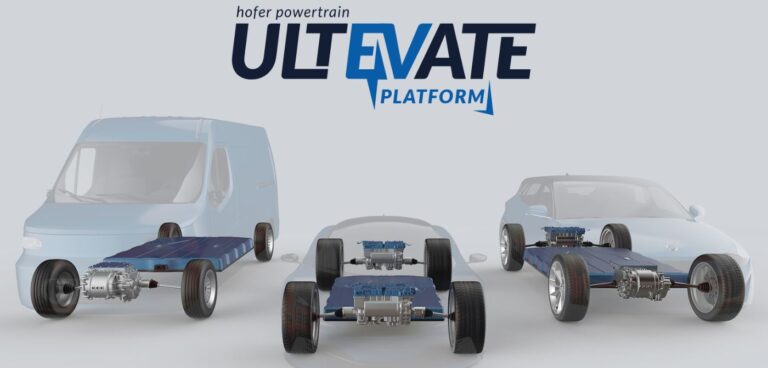After making its debut at the LA Auto Show in 2021, the Ultevate electric drive unit (EDU) platform from Hofer Powertrain has now been expanded to offer a range of new benefits. The second-generation platform features a new dual engine torque vectoring primary drive unit and a single-engine secondary axle.
To further improve the EDU, Hofer has also installed a high-voltage (HV) battery system and a vehicle control unit, in addition to an extremely efficient three-level inverter. Other notable changes include new winding technologies in the e-motors, integrated HV functions to enable charging of 800V electric vehicles at 400V charging stations, ultrafast charging technologies based on high-power cells, and intelligent battery centralization technologies to deliver enhanced safety levels, lower battery costs and increased performance.
All of these changes were made as a result of Hofer seeking to reduce overall weight while offering a high power density and efficiency.
“By expanding our portfolio, we make sure that new, more efficient and versatile powertrain combinations are possible and accessible using original and new solutions, functions and architectures,” said Thomas Hackl, chief operations officer of Hofer Powertrain.
“The main goal is not only to provide ready-to-go off-the-shelf solutions but mainly to support designing processes and build truly innovative e-drives according to individual needs of our customers, thus reducing time and costs during the development and even more in production.”
With electric and hybrid powertrains increasing in complexity and their requirements for performance, efficiency and cost effectiveness, it is vital that manufacturers understand the entire solution, right from the design and concept stage all the way to the development, vehicle integration and series production stages. To ensure all these requirements are met – and understood correctly – Hofer uses simulations and tests under varying real-world conditions to support each development phase to make calculated adjustments.
Due to the aforementioned changes, the second-generation platform now delivers efficiency, package, charging time and cost optimizations. For example, at a system level, the new architectures enable optimized package and power density for applications with a small amount of space. The output has also been increased further for the EDU on the rear axle.
Alongside all previous solutions, a single drive with a one-fits-all approach can be provided on the front axle, using the same electric motor as on the rear axle. Alternatively, an induction motor can be used to optimize the drag torque. A smaller version of the HCTV axle with up to 400kW peak can also be selected for the front axle.


